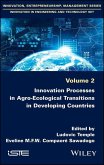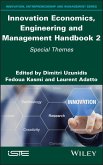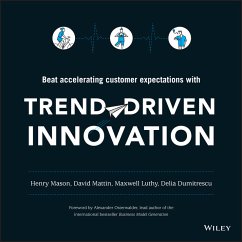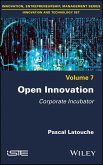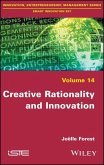

Alle Infos zum eBook verschenken

- Format: PDF
- Merkliste
- Auf die Merkliste
- Bewerten Bewerten
- Teilen
- Produkt teilen
- Produkterinnerung
- Produkterinnerung

Hier können Sie sich einloggen

Bitte loggen Sie sich zunächst in Ihr Kundenkonto ein oder registrieren Sie sich bei bücher.de, um das eBook-Abo tolino select nutzen zu können.
The end of the post-war economic boom was marked by the recognition of the environmental problem with the oil crises of the 1970s and, in 1972, the first major UN conference devoted to the human environment. Successive international meetings have resulted in a context where technical change, innovation and industry have assumed a central place in the creation of a new model of society. Against this consensus, the author demonstrates from economic analysis and wide-ranging examples that the environmental innovation doctrine and ecodesign methods remain fragile and can lead to paradoxical results.…mehr
- Geräte: PC
- mit Kopierschutz
- eBook Hilfe
- Größe: 5.12MB
![Innovation Processes in Agro-Ecological Transitions in Developing Countries (eBook, PDF) Innovation Processes in Agro-Ecological Transitions in Developing Countries (eBook, PDF)]() Innovation Processes in Agro-Ecological Transitions in Developing Countries (eBook, PDF)139,99 €
Innovation Processes in Agro-Ecological Transitions in Developing Countries (eBook, PDF)139,99 €![Innovation and Industrial Policies (eBook, PDF) Innovation and Industrial Policies (eBook, PDF)]() Joël-Thomas RavixInnovation and Industrial Policies (eBook, PDF)139,99 €
Joël-Thomas RavixInnovation and Industrial Policies (eBook, PDF)139,99 €![Innovation Economics, Engineering and Management Handbook 2 (eBook, PDF) Innovation Economics, Engineering and Management Handbook 2 (eBook, PDF)]() Innovation Economics, Engineering and Management Handbook 2 (eBook, PDF)139,99 €
Innovation Economics, Engineering and Management Handbook 2 (eBook, PDF)139,99 €![Trend-Driven Innovation (eBook, PDF) Trend-Driven Innovation (eBook, PDF)]() Henry MasonTrend-Driven Innovation (eBook, PDF)21,99 €
Henry MasonTrend-Driven Innovation (eBook, PDF)21,99 €![Enterprise Innovation (eBook, PDF) Enterprise Innovation (eBook, PDF)]() Enterprise Innovation (eBook, PDF)139,99 €
Enterprise Innovation (eBook, PDF)139,99 €![Open Innovation (eBook, PDF) Open Innovation (eBook, PDF)]() Pascal LatoucheOpen Innovation (eBook, PDF)139,99 €
Pascal LatoucheOpen Innovation (eBook, PDF)139,99 €![Creative Rationality and Innovation (eBook, PDF) Creative Rationality and Innovation (eBook, PDF)]() Joelle ForestCreative Rationality and Innovation (eBook, PDF)139,99 €
Joelle ForestCreative Rationality and Innovation (eBook, PDF)139,99 €-
-
-
Dieser Download kann aus rechtlichen Gründen nur mit Rechnungsadresse in A, B, BG, CY, CZ, D, DK, EW, E, FIN, F, GR, HR, H, IRL, I, LT, L, LR, M, NL, PL, P, R, S, SLO, SK ausgeliefert werden.
Hinweis: Dieser Artikel kann nur an eine deutsche Lieferadresse ausgeliefert werden.
- Produktdetails
- Verlag: John Wiley & Sons
- Seitenzahl: 208
- Erscheinungstermin: 27. Juli 2018
- Englisch
- ISBN-13: 9781119543947
- Artikelnr.: 53698668
- Verlag: John Wiley & Sons
- Seitenzahl: 208
- Erscheinungstermin: 27. Juli 2018
- Englisch
- ISBN-13: 9781119543947
- Artikelnr.: 53698668
- Herstellerkennzeichnung Die Herstellerinformationen sind derzeit nicht verfügbar.
Introduction xiii
Chapter 1. Environmental Innovation: A Controversial Doctrine 1
1.1. Progressive conceptualization of "environmental innovation": a journey
back through 40 years of controversies 3
1.1.1. Environmental concerns and innovations: the first proposals of
economic theory during the 1970s 4
1.1.2. Involvement in environmental technologies and green growth in the
1980s 13
1.1.3. Diverse theoretical appropriations of the concept by economic
sciences from the 1990s onwards 18
1.1.4. Conceptual beginnings and an existential crisis in environmental
innovations during the 2000s 24
1.2. Critical analysis of the typology of environmental innovations 33
1.2.1. Degrees of change of environmental innovation 34
1.2.2. "End-of-pipe" technologies: a limited palliative approach to
conservation of the environment? 36
1.2.3. Clean technologies, a preventive, radical and modular approach 39
1.2.4. The circular economy: Another form of systemic environmental
innovation 42
1.2.5. The quest for eco-efficiency, an objective based on a productivist
approach 50
1.3. Drivers of environmental innovation in the face of institutional
tensions 55
1.3.1. Modifying the dominant design, thanks to transition management
theory 56
1.3.2. Moving towards a specificity of technological trajectories of
environmental innovations? 59
1.3.3. Creation of technical conventions promoting conservation of the
environment 64
1.3.4. The rebound effect, the forgotten impacts and macrosystemic crises
70
1.4. Conclusion 76
Chapter 2. Ecodesign and Technological Change: A Missed Opportunity? 79
2.1. Ecodesign and the dispute over methods 80
2.1.1. Ecodesign during the 1970s, the metronome of a new mode of
development 81
2.1.2. First theorization and confrontation with reality during the course
of the 1980s 85
2.1.3. Birth of sustainable development and a rocky start for
industrialists 86
2.1.4. The limited effects of an "open" ecodesign philosophy 88
2.2. The main determining factors of ecodesign 96
2.2.1. Integration of the environment: the end result of total quality
management 96
2.2.2. Towards environmental declarations about products 104
2.2.3. A multitude of tools to encourage ecodesign 106
2.3. Product life cycle analysis: a limited tool for decision-making in the
face of complexity 107
2.3.1. Towards supremacy of the life cycle analysis 108
2.3.2. Product life cycle analysis: a tool weakened by complexity 113
2.4. Ecodesign confronted with environmental and economic problems 116
2.4.1. The different concepts of the environment, a multi-dimensional and
complex notion 117
2.4.2. The environment from the perspective of Boltanski and Thévenot's
"worlds" 118
2.4.3. Towards a "tragedy of change"? 121
2.5. Conclusion 126
Conclusion 129
Appendix 133
Bibliography 143
Index 165
Introduction xiii
Chapter 1. Environmental Innovation: A Controversial Doctrine 1
1.1. Progressive conceptualization of "environmental innovation": a journey
back through 40 years of controversies 3
1.1.1. Environmental concerns and innovations: the first proposals of
economic theory during the 1970s 4
1.1.2. Involvement in environmental technologies and green growth in the
1980s 13
1.1.3. Diverse theoretical appropriations of the concept by economic
sciences from the 1990s onwards 18
1.1.4. Conceptual beginnings and an existential crisis in environmental
innovations during the 2000s 24
1.2. Critical analysis of the typology of environmental innovations 33
1.2.1. Degrees of change of environmental innovation 34
1.2.2. "End-of-pipe" technologies: a limited palliative approach to
conservation of the environment? 36
1.2.3. Clean technologies, a preventive, radical and modular approach 39
1.2.4. The circular economy: Another form of systemic environmental
innovation 42
1.2.5. The quest for eco-efficiency, an objective based on a productivist
approach 50
1.3. Drivers of environmental innovation in the face of institutional
tensions 55
1.3.1. Modifying the dominant design, thanks to transition management
theory 56
1.3.2. Moving towards a specificity of technological trajectories of
environmental innovations? 59
1.3.3. Creation of technical conventions promoting conservation of the
environment 64
1.3.4. The rebound effect, the forgotten impacts and macrosystemic crises
70
1.4. Conclusion 76
Chapter 2. Ecodesign and Technological Change: A Missed Opportunity? 79
2.1. Ecodesign and the dispute over methods 80
2.1.1. Ecodesign during the 1970s, the metronome of a new mode of
development 81
2.1.2. First theorization and confrontation with reality during the course
of the 1980s 85
2.1.3. Birth of sustainable development and a rocky start for
industrialists 86
2.1.4. The limited effects of an "open" ecodesign philosophy 88
2.2. The main determining factors of ecodesign 96
2.2.1. Integration of the environment: the end result of total quality
management 96
2.2.2. Towards environmental declarations about products 104
2.2.3. A multitude of tools to encourage ecodesign 106
2.3. Product life cycle analysis: a limited tool for decision-making in the
face of complexity 107
2.3.1. Towards supremacy of the life cycle analysis 108
2.3.2. Product life cycle analysis: a tool weakened by complexity 113
2.4. Ecodesign confronted with environmental and economic problems 116
2.4.1. The different concepts of the environment, a multi-dimensional and
complex notion 117
2.4.2. The environment from the perspective of Boltanski and Thévenot's
"worlds" 118
2.4.3. Towards a "tragedy of change"? 121
2.5. Conclusion 126
Conclusion 129
Appendix 133
Bibliography 143
Index 165

